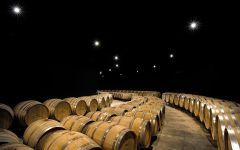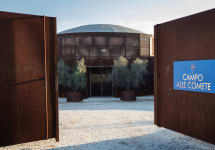Campo alle Comete Rosato 2020
-
James
Suckling



Product Details
Your Rating
Somm Note
Winemaker Notes
This wine is a brilliant dusky pink. On the nose it is intense and rich, with notes of fresh herbs and sweet fruity hints of raspberry and cherry. On the palate, fresh and balanced, with a fruity and persistent aftertaste.
Great for starters based on vegetables and fish, like smoked salmon. It goes well with risotto and pasta with seafood, shellfish as well as to every kind of fish (baked or grilled) and sushi. Also enhances with chicken or turkey dishes.
Professional Ratings
-
James Suckling
A bright, salmon-colored rosé with aromas of cherries, pomegranate and herbs. It’s medium-bodied with tangy acidity. Fruity, flavorful and dry. From organically grown grapes.
Other Vintages
2022-
James
Suckling




Campo alle Comete estate is located at the foot of Castagneto Carducci, in province of Livorno. The property extends over 17 Ha, 14.5 of which are vineyards and 2.5 hectares are olive trees. The grape varieties Merlot, Cabernet Sauvignon, Cabernet Franc, Syrah and Petit Verdot, planted between 1993 and 2007, are all written into the Bolgheri DOC registry.
The winery practices sustainable farming, and in 2016 they started the conversion of the vineyards to organic. The type of soil is mostly loose/sandy with some clay and a part of limestone. The mild temperatures, constant winds, and significant temperature fluctuations between day and night create ideal conditions for a balanced growth of the vines and an excellent grape maturation. The result are healthy grapes, favored by a lower attack of botrytis and diseases. Their aromatic, intense scents and their ripe, fine tannins characterize the wines and create a good pleasantness even at an early age.
The estate was acquired in February 2016 by famous Feudi di San Gregorio winery in Tuscany. The name Campo alle Comete is an antique toponym from this area, which disappeared over time. The whole representation of Campo alle Comete, with its magical name (Cometa means “guiding star” or "Comet" in Italian), wants to bring the consumer into a dream world. Nicoletta Ceccoli, an illustrator from San Marino and winner of various art awards, has designed not only its logo but also a dreamlike picture, exhibited at the winery, from which they have also taken the fairy images represented in the labels. The director of Campo alle Comete is Jeanette Servidio. Together with oenologist Stefano Di Blasi, she has created 4 high quality wines within the DOC Bolgheri and IGT Toscana appellations.

Whether it’s playful and fun or savory and serious, most rosé today is not your grandmother’s White Zinfandel, though that category remains strong. Pink wine has recently become quite trendy, and this time around it’s commonly quite dry. Since the pigment in red wines comes from keeping fermenting juice in contact with the grape skins for an extended period, it follows that a pink wine can be made using just a brief period of skin contact—usually just a couple of days. The resulting color depends on grape variety and winemaking style, ranging from pale salmon to deep magenta.

An outstanding wine region made famous by Marchese Mario Incisa della Rocchetta, who planted Cabernet Sauvignon vines for his own consumption in 1940s on his San Guido estate, and called the resulting wine, Sassicaia. Today the region’s Tuscan reds are based on Cabernet Sauvignon and Merlot, which can be made as single varietal wines or blends. The local Sangiovese can make up no more than 50% of the blends. Today Sassicaia has its own DOC designation within the Bogheri DOC appellation.
